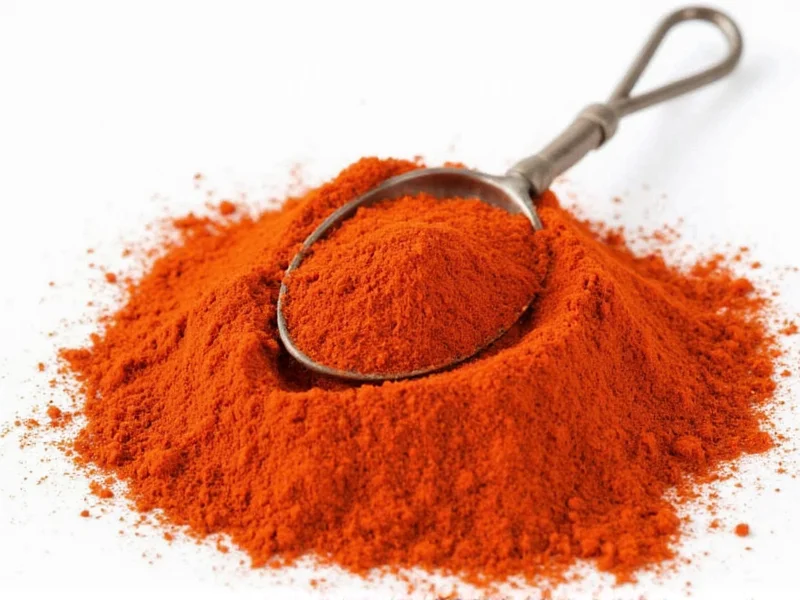Running out of paprika while cooking doesn't have to ruin your recipe. Whether you're making Hungarian goulash, Spanish paella, or a simple spice rub, knowing what to substitute for paprika can save your dish. This guide provides practical alternatives based on the specific type of paprika you're missing and the culinary context of your recipe.
Understanding Paprika Varieties Before Substituting
Paprika isn't a single spice but comes in several varieties with distinct flavor profiles. Choosing the right substitute requires identifying which type you need to replace:
- Sweet paprika - Mild, slightly sweet, vibrant red color
- Smoked paprika - Deep, smoky flavor from dried peppers smoked over oak
- Hot paprika - Contains spicy Capsicum varieties
| Type of Paprika | Best Substitute | Substitution Ratio | Best For |
|---|---|---|---|
| Sweet paprika | Chili powder | 1:1 | Stews, soups, marinades |
| Smoked paprika | Chili powder + liquid smoke | 1 tsp chili powder + 2-3 drops liquid smoke | BBQ rubs, roasted vegetables, bean dishes |
| Hot paprika | Cayenne pepper | 1:3 (1/3 tsp cayenne per 1 tsp paprika) | Spicy sauces, chorizo, hot dishes |
| Sweet paprika | Tomato paste + pinch of cayenne | 1 tbsp tomato paste + 1/8 tsp cayenne per tsp | Tomato-based sauces, stews |
| Smoked paprika | Chipotle powder | 1:1 (milder flavor) | Southwestern dishes, chili |
Detailed Paprika Substitution Guide
Best Substitutes for Sweet Paprika
When your recipe calls for standard sweet paprika, chili powder makes the most straightforward replacement. Most commercial chili powders contain cumin, garlic powder, and oregano alongside ground chilies, creating a similar flavor profile to sweet paprika with slightly more complexity.
For recipes where color matters as much as flavor (like deviled eggs or potato salad), consider using tomato paste diluted with a small amount of water. The natural red pigment provides visual similarity while contributing complementary flavor to tomato-based dishes.
Replacing Smoked Paprika Effectively
Smoked paprika's distinctive flavor comes from peppers dried over oak fires. When substituting for smoked paprika, focus on replicating that smoky dimension. The most reliable kitchen hack involves combining regular chili powder with liquid smoke—just 2-3 drops per teaspoon of chili powder mimics authentic smoked paprika.
Chef's tip: For recipes like Spanish chorizo or paella where smoked paprika is essential, chipotle powder works as a 1:1 substitute, though it brings additional heat. If your dish shouldn't be spicy, reduce the chipotle powder to 3/4 teaspoon per teaspoon of smoked paprika required.
Substituting for Hot Paprika
Hot paprika contains spicy Capsicum varieties, so your substitute must deliver both color and heat. Cayenne pepper provides the closest heat profile but is significantly more potent. Always use a 1:3 ratio (one-third the amount of cayenne compared to hot paprika) to avoid overwhelming your dish.
For recipes requiring both heat and the characteristic red color of hot paprika, combine tomato paste with a pinch of cayenne. This works particularly well in Hungarian dishes like chicken paprikash where the vibrant color matters as much as the mild heat.
Recipe-Specific Substitution Advice
Certain dishes have specific requirements that affect your choice of paprika substitute:
- For rubs and dry seasonings: Stick with dry spice alternatives like chili powder or cayenne rather than wet substitutes like tomato paste
- For soups and stews: Tomato paste-based substitutes integrate well and enhance body
- For deviled eggs or potato salad: Focus on color-matching substitutes like tomato paste to maintain visual appeal
- For Spanish or Hungarian dishes: Prioritize flavor authenticity—smoked alternatives work better for Spanish recipes, while sweet alternatives suit Hungarian cuisine
Common Paprika Substitution Mistakes
Avoid these frequent errors when looking for what to substitute for paprika:
- Using paprika interchangeably: Sweet, smoked, and hot varieties serve different culinary purposes
- Ignoring color impact: Some substitutes won't provide paprika's vibrant red hue
- Overcompensating with heat: Cayenne is much hotter than even hot paprika
- Adding liquid smoke directly to dry rubs: Liquid smoke should be diluted or used sparingly in dry applications
When to Skip Substitution Entirely
Some dishes rely so heavily on paprika's unique flavor that substitutes won't deliver satisfactory results. Traditional Hungarian goulash and Spanish chorizo recipes should ideally use authentic paprika. If you frequently cook these dishes, keeping a small supply of each paprika variety on hand prevents last-minute substitution dilemmas.











 浙公网安备
33010002000092号
浙公网安备
33010002000092号 浙B2-20120091-4
浙B2-20120091-4